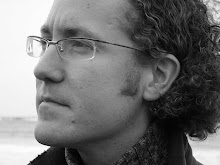My presentation seemed to go well. As always, I was bizarrely calm whilst presenting. The audience seemed to appreciate and follow what I was presenting so I rewarded them with some entertaining visuals (well, I thought they were entertaining). Received some useful feedback from various people after the presentation which will, hopefully find its way into my thesis.
Quick Thesis Update:
Deadline = 16th December
Percentage written = 30% (yikes!)
For those who are interested I'll whet your appetite with the abstract for my DDD. If you have any questions about it or want to know more don't hesitate to contact me. My plan is to write some journal publications based on this data immediately after I submit my thesis so hold on in there for the official unveiling of this stuff.
Title: An Attention-based Theory of Continuity Editing: A Draft Dissertation Defence
Date: Wednesday 5th October 2005
Abstract:
All film and television productions are constructed according to a set of conventions developed during the first two decades of the 20th century. These conventions are collectively referred to as the “rules of continuity editing”, and enable a filmmaker to construct a film in a manner that makes the artificial visual disruption occurring during an edit invisible to the viewer whilst maintaining the impression of continuous action. Achieving this “continuity” is the goal of all mainstream editing yet the concept is poorly understood and has never received an in depth scientific examination. The intention of this thesis is to rectify this neglect and in doing so advance our understanding of how we perceive edited visual media.
A cut (an instantaneous change from one camera shot to another) creates a sudden disruption of the entire visual scene which, under normal viewing conditions would involuntarily capture a viewer’s attention (Lang, 2000). This would make the viewer aware of the editing and has been shown to have negative effects on comprehension (Frith & Robson, 1975) and arousal (Lang, Zhou, Schwartz, Bolls, & Potter, 2000). For a cut to occur without attentional capture, the continuity editing rules must create viewing conditions under which attention is suppressed or occupied, or the attracting quality of the disruption minimised. During this talk I will present examples of editing rules that I have empirically shown to utilise these processes.
Three main phenomena will be presented that explain how natural modulations of attention during normal scene viewing can be used to explain how continuity editing rules function: event segmentation (Zacks et al., 2001), visual occlusion (Michotte, 1991), and saccadic eye movements (Yarrow, Haggard, Heal, Brown, & Rothwell, 2001). The close compatibility between these natural cognitive phenomena and the editing rules indicates that “continuity” is actually a combination of spatiotemporal continuity and existence constancy. These properties do not have to be created as they are assumed to continue unless we are made aware of their absence. Therefore, the editing rules function by ensuring continuity of attention which in turn guarantees perceptual continuity.
ReferencesFrith, U., & Robson, J. E. (1975). Perceiving the language of films. Perception, 4(1), 97-103.
Lang, A., Zhou, S., Schwartz, N., Bolls, P. D., & Potter, R. F. (2000). The Effects of Edits on Arousal, Attention, and Memory for television Messages: When an Edit is an Edit Can An Edit Be Too Much? Journal of Broadcasting and Electronic Media, 44, 94-109.
Lang, A. (2000). The Limited Capacity model of Mediated Message Processing. Journal of Communication, 50, 46-70.
Michotte, A. (1991). On phenomenal permanence: facts and theories. G. Thines, A. Costall, & A. Butterworth (Editor), Michotte's experimental phenomenology of perception (pp. 122-139). Hillsdale, NJ, US: Erlbaum. Notes: (Original work published 1950)
Yarrow, K., Haggard, P., Heal, R., Brown, P., & Rothwell, J. C. (2001). Illusory perceptions of space and time preserve cross-saccadic perceptual continuity. Nature, 414.
Zacks, J., Braver, T. S., Sheridan, M. A., Donaldson, D. I., Snyder, A. Z., Ollinger, J. M., Buckner, R. L., & Raichle, M. E. (2001). Human brain activity time-locked to perceptual event boundaries. Nature Neuroscience, 4(6), 651-655.




No comments:
Post a Comment